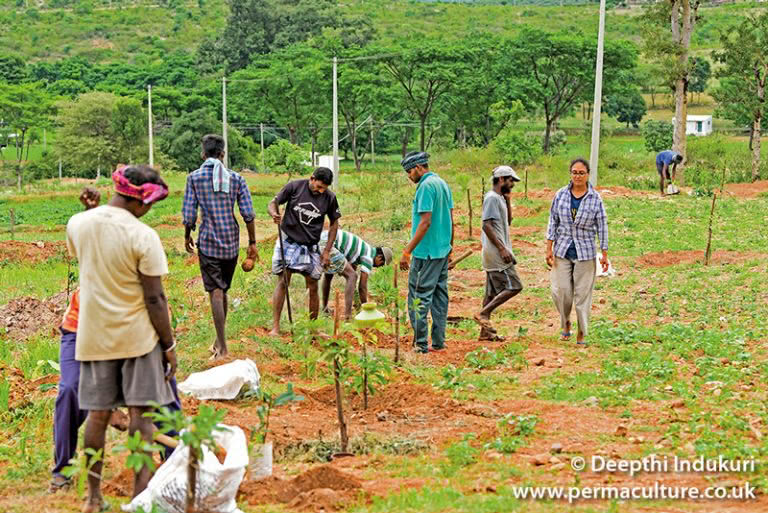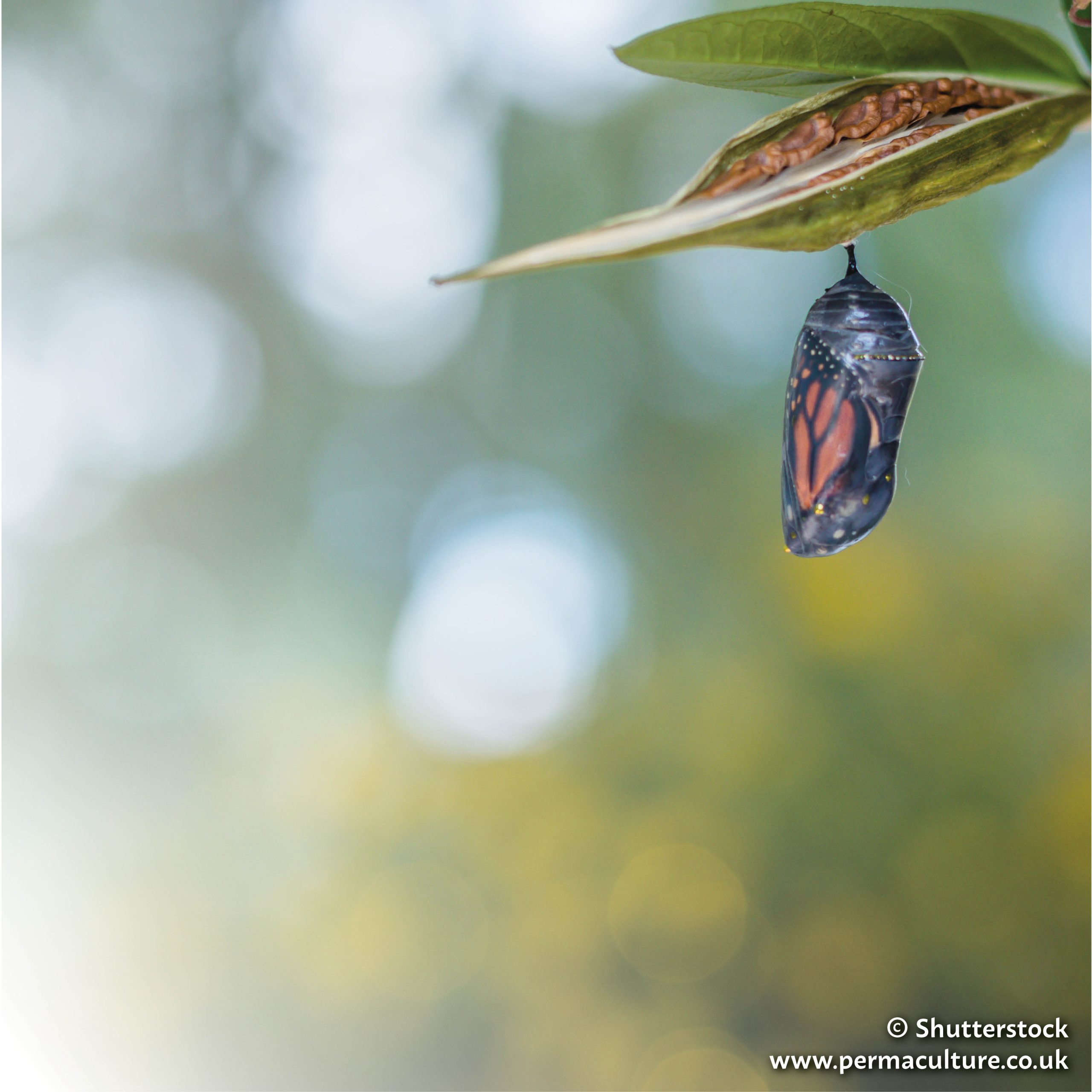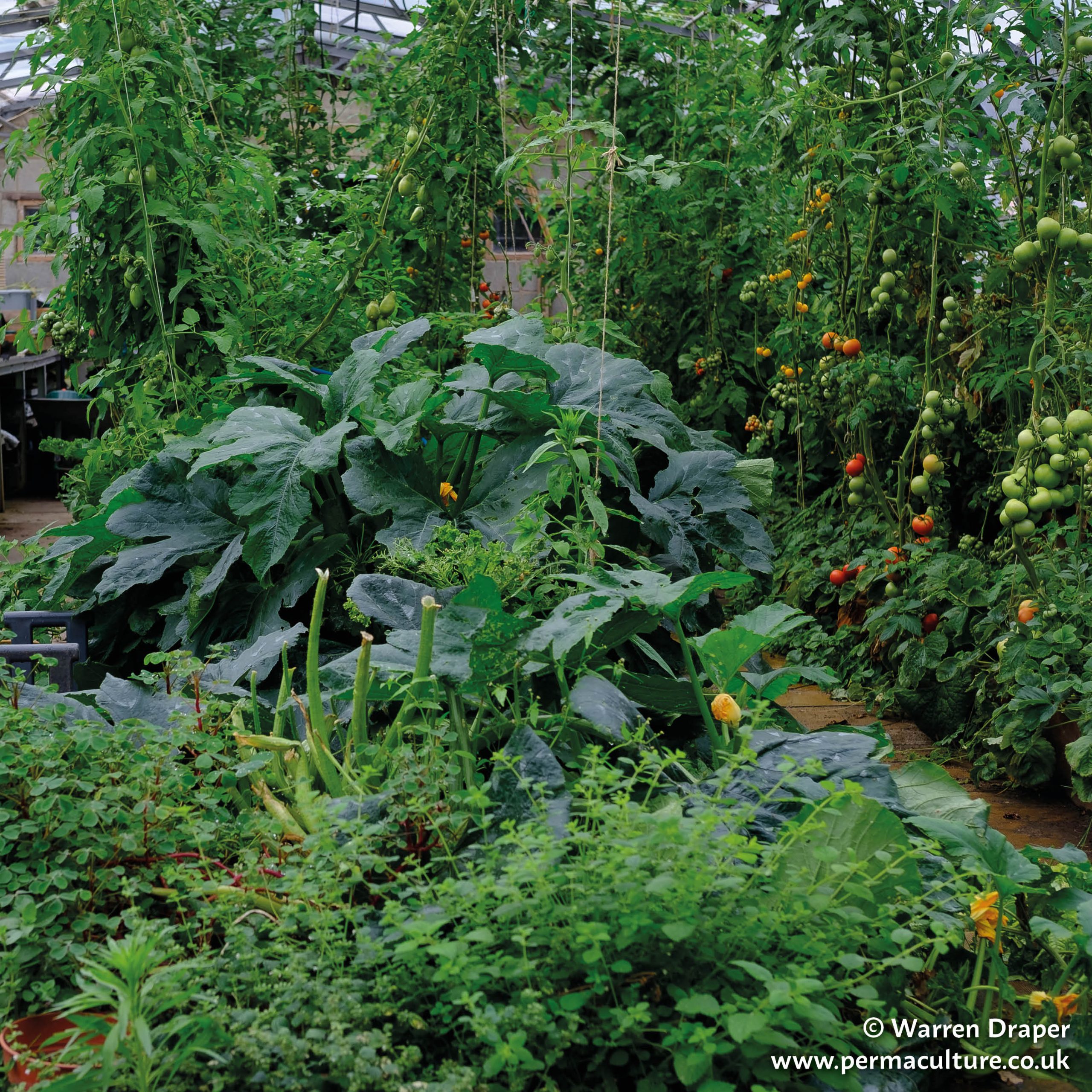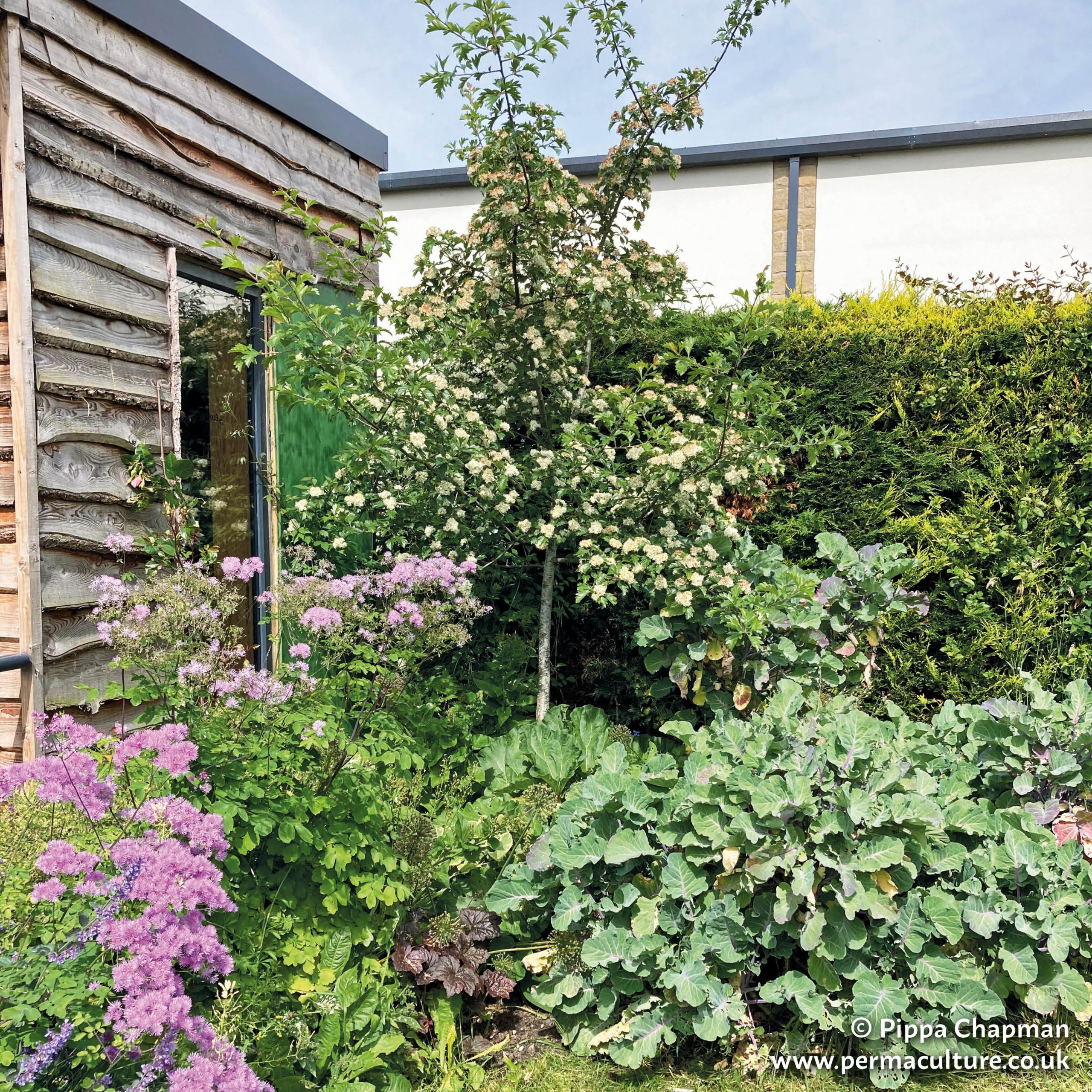Not all permaculturists or permaculture projects are vegan, and I’ve often been asked whether a completely animal-free permaculture is even actually possible. My response is, of course not, and neither would it be desirable. For example, how would we fence out the earthworms that build our soil and maintain its fertility, or the bees that pollinate our fruit trees and vegetables, and why ever would we wish to? In fact, we actively design in features that are intended to attract wildlife: ponds for frogs, toads and dragonflies, and flowering plants to bring in the ladybirds and hoverflies that keep populations of potential pests like slugs and aphids in check, and are essential to maintaining healthy productive ecosystems. What we don’t include are those ‘system components’ that we believe perpetuate exploitative relationships with our non-human Earth co-citizens, such as pigs, goats and chickens, whose primary function is the production of meat, milk and eggs.
The Naturewise forest garden in north London is one example of an edible landscape that is ostensibly ‘stock free’, although in actuality members of several of the Kingdoms of Nature work together here for mutual benefit. Deep rooted comfrey plants mine nutrients like nitrogen, potassium and phosphorous from the subsoil, making them available to fruit trees and bushes. Birds and bees buzz around the canopy layer, whilst insects and arthropods patrol the undergrowth and leaf litter, checking and balancing pest populations and playing their role in the cycles of growth and decay. Fungi and bacteria continue the process. These break down dead matter into rich humus and minerals that are exchanged with plant roots via associations with mycorrhizal soil networks in return for sugars and carbohydrates manufactured by photosynthesis. Based on the structure of natural woodland, the forest garden is a complex web of which humans too are an integral part. Aside from a bounty of apples, pears, figs, grapes, strawberries, currants and edible leaves, one of the most important yields of this mini-woodland is the sense of community that the space offers to the volunteers that spend time here. And being situated in a school playground it also acts as an open air classroom where children of many ethnic and cultural backgrounds are able to interact with nature, an opportunity that is often all too rare in the inner city.
Seasonal food is fresher and so tends to be tastier and more nutritious, supports local farmers and growers and has a number of environmental benefits, such as reducing the energy (and associated CO2 emissions) needed to grow and transport the food we eat. The suggested menu ideas below can be adapted to other foods that are available throughout the year.
Spring
Muesli, bean sprouts, seasonal greens, salads, chickweed, spring onion and alfalfa sprouts, nuts, sunflower and pumpkin seeds, green juices, sprout and spring leaves detox salad, steamed vegetables, fresh beetroots, leek and broccoli croustade, pasta and tomato sauce, spinach soup, broad bean patties, raw energy nut loaf, barley risotto, sea beet soup, vegetable curry, dried and stored fruit.
Autumn
Muesli, bean sprouts, seasonal greens, salads, nuts, sunflower and pumpkin seeds, green juices, steamed seasonal vegetables, new potatoes, Bircher potatoes, courgette and tomato bake, marrow and butternut squash tagine, bean and vegetable casserole, raw carrot savoury, nut roast, mushroom flan, barley risotto, acorn roast, quinoa pudding, sea beet and tomato soup, apple casserole, apple and blackberry cobbler, fresh seasonal fruit.
Summer
Muesli, bean sprouts, seasonal greens, new potatoes, salads, nuts, sunflower and pumpkin seeds, green juices, tomato soup, green bean medley, raw spicy leek and broccoli soup, ratatouille, gazpacho, pasta and tomato sauce, roasted summer vegetables, raw nut balls, raw energy nut loaf, spinach and chickpea curry, buckwheat casserole, stuffed peppers, English curry, stir fry with sweet and sour sauce, seasonal fruit salad.
Winter
Porridge oats, bean sprouts, seasonal greens, winter salads, nuts, sunflower and pumpkin seeds, green juices, steamed seasonal vegetables, shepherd(ess) pie, lentil pie, colcannon, roasted winter vegetables, leek and potato soup, chestnut roast, cream of celeriac soup, parsnip, kale and lentil soup, vegetable wellington, stewed fruit, puddings, fruit cake, fruit from storage.
Kimchi is a traditional Korean dish made of vegetables that have undergone lactic fermentation. The most commonly used ingredients are Chinese cabbage, carrots and radishes, although practically any other vegetables can be used.
Cut the cabbage in half lengthwise, then crosswise into 5cm (2in) pieces, discarding the root end. Place in a large ceramic bowl with salt and add enough water to cover. Weigh the cabbage down with a plate to ensure it remains submerged. Leave for between 12-24 hours or so, then drain and rinse.
Shred the carrots and radish and finely chop the spring onions and garlic, then combine all ingredients together, ensuring that all are evenly coated with the chilli, garlic and paprika mixture.
Pack into large fermenting jars. The mixture should begin bubbling after a few hours.
Leave for a week or so, opening the jars occasionally to let the gasses escape. Kimchi should keep indefinitely, but needs to be refrigerated once a jar is opened.
1 large Chinese napa cabbage
4 medium carrots
1 medium daikon radish
6-8 garlic cloves (one bulb)
¼ cup fresh ginger, minced
¼ cup paprika
¼ cup red chilli pepper powder
½ cup sea salt
A handful of spring onions
Water
Pre-heat oven to around 180°C (350°F).
Combine breadcrumbs, ground almonds, nuts or seeds and mix with vegetable oil until the mixture has a crumbly texture. Spread the mixture over the base of an oiled baking tin. Bake for about 10 minutes, until the top starts to brown.
Clean and chop the leeks and broccoli, and gently fry in olive oil until tender. Spread the leeks over the baked base.
Next make a white sauce. Heat the oil in a pan, stir in the flour, then gradually add in the soya milk, stirring constantly until the sauce thickens. Pour the sauce over the leeks and return the dish to the oven for about half an hour, or until the top is golden brown.
Serve with potatoes or a green salad.
Variations – instead of leeks try broad beans, courgettes, mushrooms, sweetcorn or anything else you fancy.
1 head of purple sprouting broccoli
2 large leeks
½ cup ground almonds
1 cup breadcrumbs
¼ cup of nuts and/or seeds, e.g. sunflower or pumpkin, finely chopped
Vegetable oil
For the white sauce:
1tbsp cornflour
2tbsp oil
1¼ cups sugar free soya milk
From The Lemon Jelly Gardener’s Cookbook, a community project encouraging young children to grow their own food and eat healthily: “This recipe is spicy but not too hot. You can change the amounts of chilli, coriander and cumin up or down a little bit. You should use an oil that is especially for deep-frying as these oils get hot enough to cook the pakora so they are nice and crisp and not soggy.
Of course you do not have to use all these different vegetables and you can add your own favourites but we warn you peas are good for frying, cucumber is not.”
Wash all the vegetables thoroughly. Peel and cut the potatoes into thin slices. Cut the cauliflower into little pieces like mini cauliflowers the size of a daisy. Chop the pepper and carrot into very small pieces about the size of big peas. Cut the onion into thin slices – the potatoes and the onion should be thin enough to be bendy so they can wrap around the smaller chunks of vegetables a bit.
Put all the raw vegetables and all the other ingredients into a big bowl, add water until the flour becomes a paste thick enough to cover the vegetables and stick to them without dripping off too much. It is best to do this by adding a bit of water at a time.
Heat up your oil in a deep fat frying pan to a medium heat. Scoop up a tablespoon of the mixture in the bowl and put it carefully into the frying pan. Cook the mixture until it is a golden brown colour and then put it onto some kitchen roll to drain off a bit of the oil.
Keep cooking spoonfuls of the mixture until it is all done. You can eat it as you go or keep them warm in the oven until you have a big plateful – be careful; they will be very, very hot when they first come out of the pan.
1 medium carrot
½ small cauliflower
220g (8oz) gram flour
1 medium onion
1 small pepper
3 large potatoes
½tsp chilli powder
1tsp coriander seeds
½tsp ground coriander
½tsp ground cumin
¼tsp salt
Thanks to the Lemon Jelly Gardener’s Project
Graham is an author and permaculture teacher and runs permaculture courses in North London through Naturewise and in West Essex at Dial House and is the founder of Spiralseed, an ethical organisation based around the three principles of permaculture, Earthcare, Peoplecare and Fair Shares.




